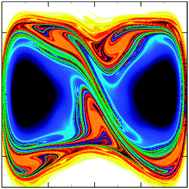Transition state geometry of driven chemical reactions on time-dependent double-well potentials
Abstract
Reaction rates across time-dependent barriers are difficult to define and difficult to obtain using standard transition state theory approaches because of the complexity of the geometry of the dividing surface separating reactants and products. Using perturbation theory (PT) or Lagrangian descriptors (LDs), we can obtain the transition state trajectory and the associated recrossing-free dividing surface. With the latter, we are able to determine the exact reactant population decay and the corresponding rates to benchmark the PT and LD approaches. Specifically, accurate rates are obtained from a local description regarding only direct barrier crossings and to those obtained from a stability analysis of the transition state trajectory. We find that these benchmarks agree with the PT and LD approaches for obtaining recrossing-free dividing surfaces. This result holds not only for the local dynamics in the vicinity of the barrier top, but also for the global dynamics of particles that are quenched at the reactant or product wells after their sojourn over the barrier region. The double-well structure of the potential allows for long-time dynamics related to collisions with the outside walls that lead to long-time returns in the low-friction regime. This additional global dynamics introduces slow-decay pathways that do not result from the local transition across the recrossing-free dividing surface associated with the transition state trajectory, but can be addressed if that structure is augmented by the population transfer of the long-time returns.

- This article is part of the themed collection: Insights from advanced methods in molecular dynamics


 Please wait while we load your content...
Please wait while we load your content...